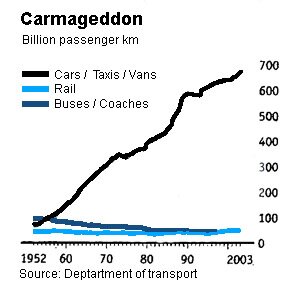4.1 Need for traffic
People need to get about. Throughout the world, the richer people are the more and further they move and cause their goods to be moved. As the economy of a country increases, so its demand for movement increases.
Despite the considerable efforts to reduce traffic, it has not stopped increasing. The discussion is not about how the total amount of traffic can be reduced, but how the rate of increase can be reduced.
Until recently streets were changed to fit in more traffic. In towns, people walked further to find a safe crossing, used forbidding underpasses, and put up with more noise, pollution and ugly traffic equipment.
Attitudes are changing. We know that existing streets and town centres will never be able to cope, if traffic continues to increase. Urban motorways are too disruptive and only help for a short time.
People can be persuaded to cause less traffic. They might walk or cycle more, use a bus or train, or simply travel less. Traffic can be reduced by high parking charges, or congestion charging. But there needs to be an acceptable alternative mode of transport, such as a more convenient bus or train and better conditions for cyclists and people on foot.
The concept of mixed use streets takes these ideas further.
BACK TO TOP
4.2 Traffic & safety
Fast traffic and frustrated drivers cause accidents. Accidents at speeds lower than 20 mph are far less severe than those at 40 mph and above. Motorways designed for high speeds are safer than country “A” roads which are simply medieval cart tracks with a few traffic signs. Where speeds are low in urban areas or villages, traffic can be safely integrated into a total public realm such as a mixed use street or shared space.
BACK TO TOP
4.3 Management of traffic
To help drivers move safely and efficiently, traffic is managed. Drivers keep to the left, move round roundabouts in a clockwise direction and only go one way along some roads. Because road space is usually at a premium, traffic signals are designed to maximise traffic flow and use road space efficiently. Pedestrians are helped to cross the road by a range of alternative styles of crossings. However, all these measures do not take from drivers the responsibility to drive safely and have consideration for other road users including pedestrians.
BACK TO TOP
4.4 Links & junctions
Roads are organised from the traffic viewpoint into links that is a stretch of road between a junction, and junctions. Because vehicles have to cross the paths of other vehicles at a junction, and therefore need to slow down or stop, it is usually at junctions where all the problems of congestion and safety occur. They are also where pedestrians need to cross. For that reason most urban and village road junctions also have a function as a public realm place as well as a movement function.

BACK TO TOP
4.5 Traffic generation: Flows and growth
Traffic is “generated” at places where people want or need to go: shopping centres, schools, offices, or rather their car parks. At present traffic is increasing in direct proportion to the national gross domestic product, or the country’s wealth. Measures to encourage more use of public transport, walking and cycling are having an effect, but the current official aim is to try to reduce the growth in traffic, not actual amount.
BACK TO TOP

